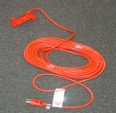 Mismanaged electrical equipment is one of the top five causes of laboratory and industrial fires. The U.S. Consumer Product Safety Commission estimates that electrical power cords cause about 4,000 injuries and 3,300 residential fires each year. The most frequent causes of such fires are short circuits, overloading, damage and/or misuse of these power cords. Misused and damaged power cords have caused painful injuries, fires, equipment damage and regulatory citations and penalties. Even the smallest amount of electrical current can cause injury or even death.
Mismanaged electrical equipment is one of the top five causes of laboratory and industrial fires. The U.S. Consumer Product Safety Commission estimates that electrical power cords cause about 4,000 injuries and 3,300 residential fires each year. The most frequent causes of such fires are short circuits, overloading, damage and/or misuse of these power cords. Misused and damaged power cords have caused painful injuries, fires, equipment damage and regulatory citations and penalties. Even the smallest amount of electrical current can cause injury or even death.
Common Hazards to Avoid with “Power” Cords
- Extension cords cannot be used in place of permanent wiring.
- Make sure your hands are dry before plugging or unplugging a power cord.
- Examine cords before each use. If the cord is damaged or frayed – DO NOT USE IT!! The damaged or frayed cord must be taken out of service and replaced immediately.
- Avoid using a power cord when the ground prong is removed.
- Never disconnect a plug from a socket by jerking the cord. Instead, grasp the plug and remove the plug from the socket.
- When working outdoors, use only weather-resistant heavy gauge extension cords marked “for outdoor use.”
- Do not drag cords over rough surfaces and never use them to lift or pull materials. Electrical cords were not designed to function as ropes.
- Never connect extension cords/power strips to each other. Doing this can overload the circuit creating a potential fire hazard.
Examples of Electrical Hazards

Electrical Panels
- Maintain 36 inches of clearance in front of electrical panels.
- Do not store combustibles near electrical panels.
- Electrical panel doors must remain closed at all times.
- Unauthorized personnel cannot access electrical panels.
- Submit a work request to install a power switch outside of the panel if one is needed.
Leave a Reply